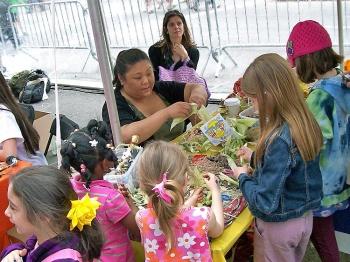David Hurd, Director of the Office of Recycling Outreach and Education (OROE) and GrowNYC suggested people may be reluctant to recycle because it’s viewed as difficult and full of rules and regulations. He insisted, “Recycling is simple.” Of course, the rules and regulations exist, but, “It’s also an everyday way [people] can fight environmental problems.”
The Textile Problem
Rather than textile recycling being a revolutionary idea, Hurd suggested it was necessary. The 2005 New York City Department of Sanitation (DOS) Bureau of Waste Prevention, Reuse, and Recycling waste stream report identified textiles as almost 6 percent of the landfill waste, as much as 193,000 tons a year. The GrowNYC pilot program started in 2007 under contract with the DOS and set out to meet the city’s recycling goal to help residents understand and participate in non-traditional curbside recycling. The key, he said, is education.
The NYC Greenmarket sites, where textile recycling is now set up, were initiated to make it easier for people to participate in GrowNYC initiatives. Previous efforts for textile recycling were semi-annual events that were hardly convenient and put barely a dent in the problem. All five boroughs have outreach representatives that now work at the various greenmarkets to promote the textile collections as well as other GrowNYC programs. Recycling is offered Friday through Monday at several locations in NYC.
Margaret Hoffman, Regional Coordinator for Upper Manhattan, Queens, and the Bronx Greenmarkets, said that GrowNYC has worked hard to increase awareness. It’s a slow process but over the past five years that she has been working for the program she has seen steady progress.
Rob Shephard said he joined GrowNYC after becoming interested in community involvement and community development and education. He has been working at the 97th St. Greenmarket for a few years. “It’s the original market and has been around for a long time,” he said. “It’s more well-known and [we] have “regulars.” He also participates because he cares about people’s well being and caring for the environment is part of that.
Promotion Citizenship
But the outreach and education doesn’t stop at the Greenmarkets. GrowNYC sponsors a public school recycling program called Recycling Champions. The Department of Education (DOE) Sustainability Initiative also produces K-12 green curriculum and promotes the greening of schools. Children learn why it’s important for them to become model recyclers and they take that information and enthusiasm home to their families. Imagine learning that the material in your local playground is recycled from old tennis shoes! To increase public awareness, GrowNYC manages an active website, has public service announcements on major networks, and provides ads for recycling tips.
To further meet their mandate of reducing textile waste, GrowNYC works collaboratively with WearableCollections (WC), a for-profit organization that collects the recycled textiles for further processing. Brent, who works at the 97th St. Greenmarket for WC, said the company mainly handles the logistics of the effort. They take the donations to a trailer in Red Hook and, when it’s full, the whole lot is sorted, baled and sold. “People donate for different reasons,” he said. “[WC] is a much better option than other alternatives.”
A local resident said she recycles because she doesn’t want materials to go into a landfill. “I wait until Friday to clean out my closets,” she said, in order to donate to the textile-recycling program.
Where it Goes
Collecting the materials is just the beginning of the process. Adam Baruchowitz, founder of WearableCollections, talked about textile recycling as profit. He started the collection in 2005 in order to raise money for spinal cord research after his best friend was paralyzed from a car accident. The world was already going green and there was a demand. It wasn’t a new concept, he said, having already been in progress in the UK. The company’s goal is to do community-based service, provide convenient collection (through the greenmarkets and residential collection projects), and, well, to make money.
Only 40 to 50 percent of the clothing is considered suitable for resale, and this has the highest value. The rest is sorted by fabric type and sold into the industrial rag market, with even less useable fabrics broken down into fibers again for mattress stuffing, insulation, and other products.
WearableCollections community efforts include fund-raising collaborations with schools, churches, and other non-profit organizations. These groups set up collection sites and receive five cents per pound. WC has collected as far away as Boston and Washington D.C., and considers their marketing and branding strategy as largely responsible for their success.
The GrowNYC and WearableCollections programs are not connected with the fashion industry, but textile recycling has found a place in that industry as well.
From Collection to Vintageto Fashion Design
The next step up, of course, would be the donation and resale of recycled clothing. Most are familiar with the efforts of non-profit organizations like Goodwill and the Salvation Army that collect used clothing and resell it to provide jobs and income for those in need. The vintage clothing business, however, takes textile recycling to the next level—upcycling. Textile recycling is not only good for the environment but it has become fashionable.
A step above vintage wear is original designs using recycled fabric. A local company, Zachary’s Smile, offers upcycled clothing in trendy designs that have been picked up by the environmentally savvy rich and famous. Using “old” clothes to make new reduces the need to produce more clothing, and reduces the glut of the textile market and its environmental waste.
All of these efforts bode well for the environment. No matter where you participate in the textile recycling chain or why, you’re reducing textile waste in landfills, reducing waste from increased textile production, and helping the global community.
For more information:
www.GrowNYC.org/recycle/simple
http://wearablecollections.com/

